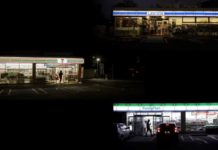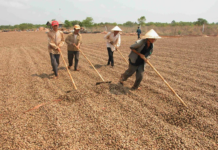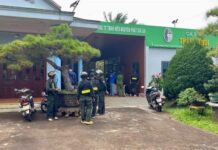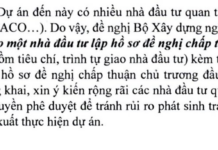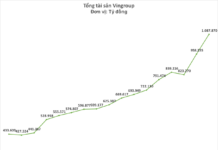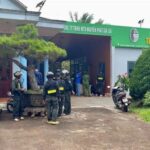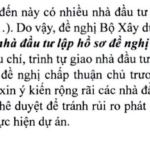Mr. Nguyen Duy Thach, Director of the Investment Preparation Board – Ho Chi Minh City Urban Railway Management Board, said that after expanding the administrative boundaries, Ho Chi Minh City has a total of 27 metro lines, with a total length of 1,012 km needing investment. Of these, the old Ho Chi Minh City area has 12 lines, the old Binh Duong area has 12 lines, and the old Ba Ria – Vung Tau area has 3 lines.
This system will form a high-capacity public transport framework, seamlessly connecting Ho Chi Minh City, Binh Duong, Dong Nai, and Vung Tau. It will also link with national railway lines and Long Thanh Airport, creating a modern transport network that alleviates the severe congestion on the existing road system.

9 priority metro lines for investment in the next 10 years in Ho Chi Minh City, with a total capital of $37.15 billion and a total length of 374.21 km. (Source: Urban Railway Management Board)
According to the Urban Railway Management Board, the old Ho Chi Minh City area previously planned 12 urban railway lines with a total length of 582 km and the use of 16 depots.
The old Binh Duong area also detailed plans for 12 metro lines, with 2 main depots. These lines are designed to connect urban areas, large industrial zones, and integrate with Ho Chi Minh City and Dong Nai.
Meanwhile, the old Ba Ria – Vung Tau area has 3 lines connecting coastal tourist centers, industrial zones, and seaports, while also integrating with the national railway system, Ho Chi Minh City metro, and the airport.
Before 2035, Ho Chi Minh City will prioritize investing in 9 metro lines with a total capital of approximately $37.15 billion. The old Ho Chi Minh City area will invest in 6 lines; the old Binh Duong area is expected to have 2 lines, and the old Vung Tau area is expected to have 1 line, which is Line 3 connecting Vung Tau – Ba Ria – Phu My, 63 km long, including the connection to Long Thanh Airport.

Among the 9 priority metro lines for investment before 2035, the old Ho Chi Minh City area has 6 lines, the old Binh Duong area has 2 lines, and Vung Tau has 1 line connecting to Long Thanh Airport – Dong Nai. (Source: Urban Railway Management Board)
Details of the 9 metro lines Ho Chi Minh City will invest in before 2035
Line 1 (An Ha – Suoi Tien) has a total length of 40.8 km, including 15.5 km underground and 25.3 km elevated. This line is expected to have 30 stations, including 14 underground and 16 elevated stations, using the An Ha Depot and Long Binh Depot.
The route is divided into two segments: The An Ha – Ben Thanh segment, 21.1 km long, runs from An Ha Industrial Zone to Le Van Quoi, Hoa Binh, Ong Ich Khiem, Lanh Binh Thang, Ly Thai To, Nga Sau Cong Hoa, Cong Quynh to Ben Thanh Market.
The Ben Thanh – Suoi Tien segment, 19.7 km long, runs from Ben Thanh Market through Le Loi, Ba Son Station, Van Thanh Park, Vo Nguyen Giap Road, Thu Duc intersection to Long Binh Depot.
The preliminary total investment is $3.28 billion, equivalent to 86,521 billion VND.
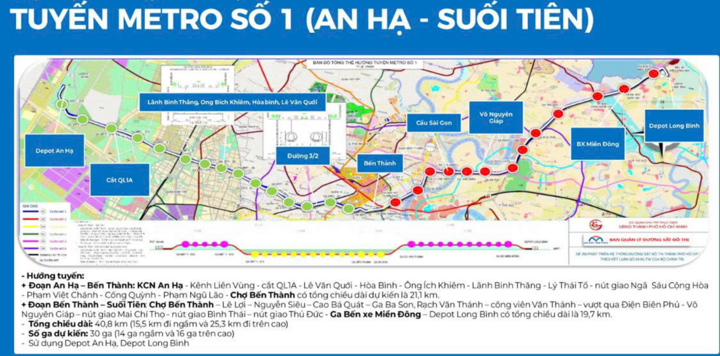
Line 1 (Ben Thanh – An Ha) is one of the metro lines Ho Chi Minh City prioritizes for investment before 2035. This line is expected to have 30 stations, including 14 underground and 16 elevated stations. (Source: Urban Railway Management Board)
Metro Line 2 (Thu Thiem – Cu Chi)
This line has a total length of 62.17 km, including 12.83 km underground and 49.34 km elevated, and is expected to have 42 stations, including 12 underground and 30 elevated stations.
The Thu Thiem – Cu Chi metro will use the Binh My Depot (Cu Chi), Tham Luong Depot, and Phuoc Hiep Depot.
The route starts from Thu Thiem, passing through Mai Chi Tho, Ham Nghi, Ben Thanh, Le Lai, Cach Mang Thang Tam, Truong Chinh, An Suong Bus Station, National Highway 22 to the Northwest Cu Chi Urban Area, with a branch to Cau Phu Cuong to connect with Binh Duong.
The preliminary total investment is $2.77 billion, equivalent to approximately 73,176 billion VND.
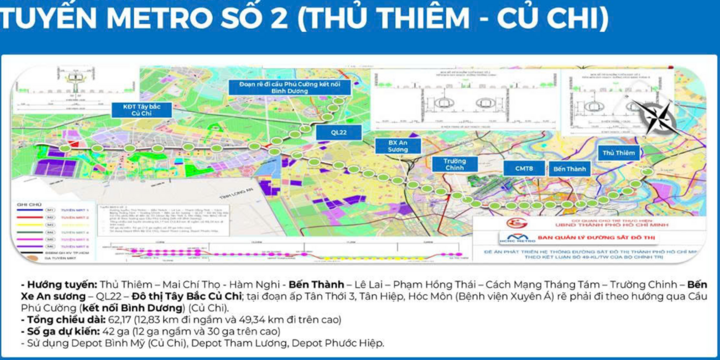
Metro Line 2 (Thu Thiem – Cu Chi), 62.17 km long, connects with Binh Duong with an expected investment of $2.77 billion. (Source: Urban Railway Management Board)
Metro Line 3 (An Ha – Hiep Binh Phuoc)
Metro Line 3, prioritized for investment before 2035, has a total length of 45.81 km, including 16.05 km underground and 29.77 km elevated.
This line is expected to have 35 stations, including 15 underground and 20 elevated stations, using the An Ha Depot, Tan Kien Depot, and Hiep Binh Phuoc Depot.
The route runs from An Ha Industrial Zone through Le Minh Xuan, Tan Kien Station, Kinh Duong Vuong, Hong Bang, Hung Vuong, Nga Sau Cong Hoa, Nguyen Thi Minh Khai, Xô Viet Nghê Tinh to National Highway 13, ending at Hiep Binh Phuoc.
The preliminary total investment is approximately $5.05 billion, equivalent to 133,308 billion VND.

Metro Line 3 An Ha – Hiep Binh Phuoc, 45.81 km long, has a total investment of over $5 billion. (Source: Urban Railway Management Board)
Metro Line 4 (Dong Thanh – Hiep Phuoc)
According to the plan, this metro line is expected to have a total length of 47.32 km, including 25.62 km underground and 21.7 km elevated.
The line includes 37 stations with 21 underground and 16 elevated stations, using the Dong Thanh Depot (Hoc Mon) and Hiep Phuoc Depot.
The route runs from Dong Thanh through Ha Huy Giap, Nguyen Oanh, Nguyen Kiem, T1 and T2 Tan Son Nhat Stations, Truong Son, Nguyen Van Troi, Hai Ba Trung, Pasteur, Ben Thanh, Nguyen Thai Hoc, Ton Dan, Nguyen Huu Tho, and follows a new road to Hiep Phuoc Urban Area.
The preliminary total investment is $5.96 billion, equivalent to 157,405 billion VND.

Metro Line 4 Dong Thanh-Hiep Phuoc, with an investment of $5.96 billion, has already attracted an investor proposal. (Source: Urban Railway Management Board)
Line 6 (Inner Ring Road)
This metro line has a total length of 53.8 km with the largest total investment, exceeding $8 billion, and is identified as a priority project.
According to the plan, this metro line includes 45.6 km underground and 8.2 km elevated. The entire line is expected to have 38 stations, including 32 underground and 6 elevated stations, using the Binh Hung, Binh Trieu, Hiep Binh Phuoc, and Long Truong Depots.
The route is divided into three segments: from Phu Huu Station to Ba Queo Station; from Ba Queo Station to Phu Lam Intersection; and the third segment from Phu Lam Intersection back to Phu Huu Station.
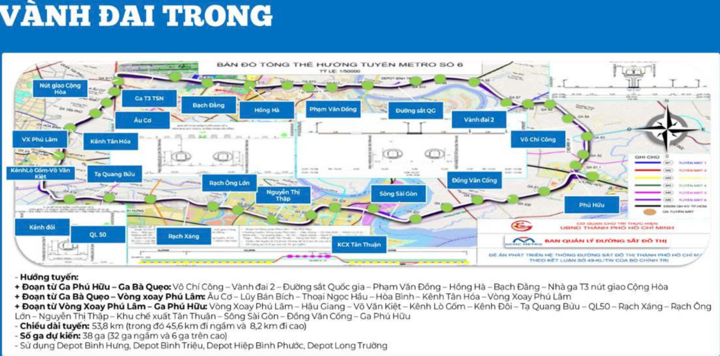
The Inner Ring Road metro line has the largest total investment among the 9 priority lines for the next 10 years, with over $8 billion. (Source: Urban Railway Management Board)
Thu Thiem – Long Thanh Line
According to the pre-feasibility study report by the Railway Project Management Board (Ministry of Construction), this line is 41.83 km long, with an expected investment of $3.21 billion, equivalent to 84,752 billion VND, directly connecting from central Ho Chi Minh City – Thu Thiem Station to Long Thanh International Airport.
This line is expected to have 40.67 km elevated and 15.13 km underground, with 0.43 km on the ground, and 20 stations, including 16 elevated and 4 underground stations.
This is a high-capacity passenger transport line, with a capacity of 30,000–40,000 passengers/direction/hour, and a design speed of up to 120 km/h on the main line and 90 km/h in tunnels.
The Prime Minister has assigned Ho Chi Minh City as the managing agency to implement this project.
Recently, the Ho Chi Minh City People’s Committee sent a document to the Dong Nai People’s Committee to discuss the procedures for assigning a locality as the competent authority to prepare the investment for the Thu Thiem – Long Thanh railway line.
According to the Ho Chi Minh City People’s Committee, the city has received much interest from investors in the Thu Thiem – Long Thanh Railway Project. Investors mainly propose public-private partnership (PPP) models, specifically the Build-Transfer (BT) contract.
To expedite investment preparation, it is necessary to agree on assigning a locality as the competent authority for implementation.
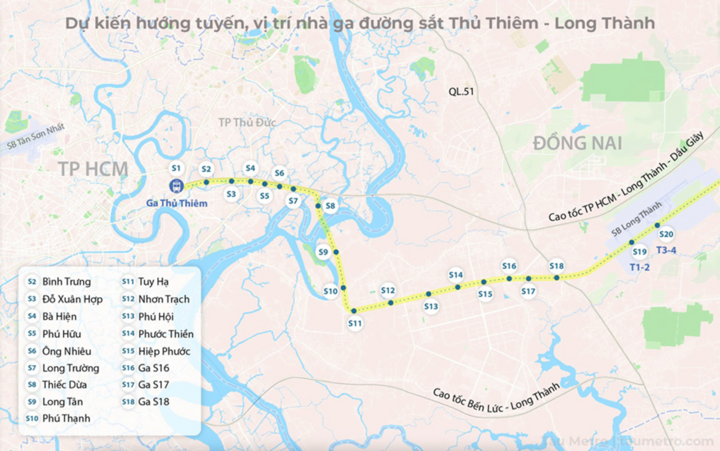
The Thu Thiem – Long Thanh railway is expected to commence commercial operations in 2030.
The old Binh Duong area has 2 priority lines for investment before 2035: Line 1 (New Binh Duong City – Suoi Tien) and Line 2 (Thu Dau Mot City – Ho Chi Minh City).
Metro Line 1 New Binh Duong City – Suoi Tien
Metro Line 1 connects from New Binh Duong City to Suoi Tien Station of Metro Line 1 Ben Thanh – Suoi Tien, with a total length of 32.43 km, including a 29.01 km main line entirely elevated and a 3.42 km depot connection.
The line starts at S1 Station in the center of New Binh Duong City and ends at Suoi Tien Bus Station of Metro Line 1 Ben Thanh-Suoi Tien. The entire line is expected to have 19 elevated stations and 1 depot located in Binh Duong Ward. The total investment is expected to be $2.27 billion, equivalent to 46,725 billion VND.
On August 16, the Ho Chi Minh City People’s Committee issued a decision assigning the Urban Railway Management Board as the investor to prepare the investment for this metro line.

Ho Chi Minh City has assigned the Urban Railway Management Board as the investor to prepare the investment for Metro Line 1 New Binh Duong City – Suoi Tien. (Source: Urban Railway Management Board)
Metro Line 2 Thu Dau Mot – Ho Chi Minh City
Metro Line 2 Thu Dau Mot – Ho Chi Minh City is 21.87 km long, entirely elevated; it starts at S5 Station of Metro Line 1 New Binh Duong City – Suoi Tien and ends at km24+865 in Binh Hoa Ward.
The entire line is expected to have 13 elevated stations and 1 depot shared with the depot of Metro Line 1 New Binh Duong City-Suoi Tien.
The total investment for this line is expected to be $2.27 billion, equivalent to 59,968 billion VND.

Metro Line 2 Thu Dau Mot – Ho Chi Minh City, 21.87 km long, with an investment of approximately $2.27 billion, is also among the metro projects prioritized for investment before 2035. (Source: Urban Railway Management Board)
Metro Line 3 Vung Tau- Ba Ria-Phu My
The old Ba Ria – Vung Tau area, according to the plan, has 3 metro lines. In the phase before 2035, Ho Chi Minh City will prioritize investing in Line 3 connecting Vung Tau – Ba Ria – Phu My.
This line is 63 km long, including a 23 km connection to Long Thanh Airport (previously planned at 40 km). It starts at Cua Lap – Bung Vung Vanh Intersection – National Highway 55 – Hoa Binh Park Intersection – National Highway 51 – Phu My Industrial Zone, connecting to Long Thanh Airport.
The expected investment is $4.83 billion, equivalent to 127,645 billion VND.
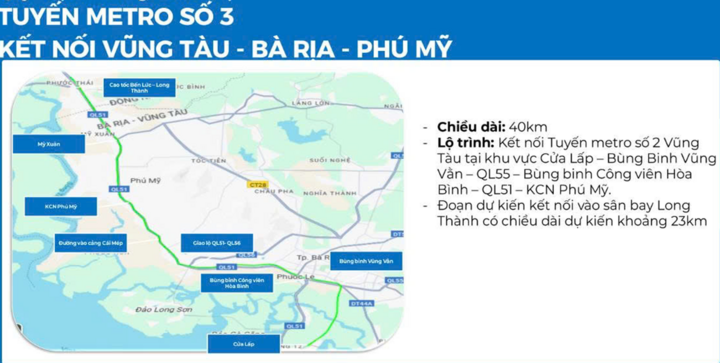
Metro Line 3 Vung Tau- Ba Ria-Phu My, connecting to Long Thanh Airport, has an expected investment of $4.83 billion. (Source: Urban Railway Management Board)
Additionally, during this phase, 2 important metro lines will also be invested in: Line 12 Ho Chi Minh City – Can Gio and Line Ben Thanh-Tham Luong.
At the Ho Chi Minh City Socio-Economic Meeting for the first 10 months of 2025 on October 31, Mr. Tran Quang Lam, Director of the Department of Construction, said that the department is completing procedures for Metro Line 2 Ben Thanh – Tham Luong to start construction by the end of this year or at the latest in January 2026. This project is expected to complete the urban connection axis from the West to the Northeast of the city.

Metro Line 2 Ben Thanh-Tham Luong has completed land clearance and is preparing for construction conditions.
Regarding the metro line to Can Gio, Mr. Lam said that Vingroup is accelerating preparation steps, aiming to start construction by the end of this year. For this line, Ho Chi Minh City has agreed to adjust the starting point to Ben Thanh Station instead of Tan Thuan Station as previously proposed.
According to the new proposal, the segment from Ben Thanh to Tan Thuan will go underground; the segment from Tan Thuan to Can Gio will follow the original plan. According to the old design, the line is about 48.56 km long, expected to have 4 stations, combining underground sections in residential areas and elevated sections along the Rung Sac road. If following the new plan, the Ho Chi Minh City – Can Gio metro line will increase by about 5 km.

Vingroup is accelerating preparation steps, aiming to start construction of Metro Line 12 Ho Chi Minh City – Can Gio by the end of this year.

According to the plan, after the merger, Ho Chi Minh City will have 27 metro lines with a total length of over 1,000 km.
According to Mr. Nguyen Duy Thach, the Urban Railway Management Board is reviewing and updating the urban railway network planning to ensure effective connectivity among the three areas.
This includes assessing intersection locations, depot areas, unified control centers, and building a unified technical standard system for the entire network, ensuring the metro system operates synchronously, safely, and optimally across the city.
Currently, many private enterprises have actively participated in investing in the urban railway system in Ho Chi Minh City, such as Vingroup investing in the urban railway line connecting central Ho Chi Minh City to Can Gio District; Truong Hai, in collaboration with Hyundai Rotem, participating in the investment and construction of Metro Line 2 segments Ben Thanh – Tham Luong, Ben Thanh – Thu Thiem, and Thu Thiem – Long Thanh; and Sovico Group researching the urban railway line number 4 connecting Hoc Mon – Nha Be…
Ho Chi Minh City Allocates $240 Million to Upgrade Southern Central Road Network
Discover the transformative expansion of Ton That Thuyet Road in Ho Chi Minh City, a $5.621 trillion VND project set to redefine urban connectivity. With the relocation of 598 households, this initiative includes the construction of a new bridge, riverbank reinforcement, and a scenic park along the Kenh Te Canal, blending infrastructure with green spaces for a modern, vibrant cityscape.
Unlocking Land Valuation Challenges: Ho Chi Minh City Resolves Pricing Issues for Lakeview City and New City Projects
The Ho Chi Minh City Department of Agriculture and Rural Development has submitted for appraisal the re-evaluation of land prices for the Lakeview City project and the 1.330-unit New City residential development. The Ho Chi Minh City Land Price Appraisal Council has also convened a meeting to reassess these valuations.
Young CEO (Born 1995) Leads Research on $5.7 Billion Project
This is a pivotal transportation project, seamlessly linking Tan Son Nhat Airport with Long Thanh Airport.

